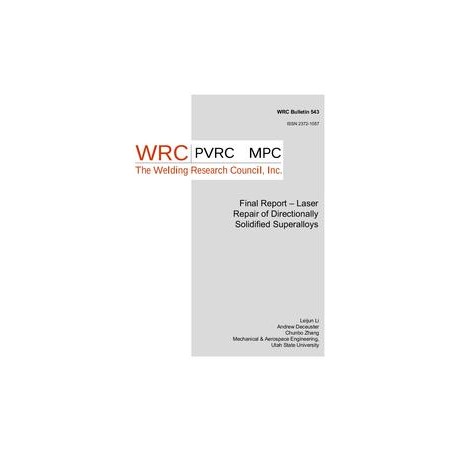Cart
0
Product
Products
(empty)
No products
To be determined
Shipping
$0.00
Total
Product successfully added to your shopping cart
Quantity
Total
There are 0 items in your cart.
There is 1 item in your cart.
Total products
Total shipping
To be determined
Total
 View larger
View larger
WRC 543
M00002284
New product
WRC 543 Final Report - Laser Repair of Directionally Solidified Superalloys
Bulletin / Circular by Welding Research Council, 2014
L. Li, A. Deceuster, C. Zhang
In stock
More info
Full Description
Directionally solidified nickel based superalloys, such as GTD-111, were repaired using pulsed Nd:YAG laser powder deposition (PLPD). The pulsed laser deposition offers a number of advantages due to its significantly lowered heat input to the workpiece and therefore a much narrower heat-affected zone, smaller dilution, and less tendency to form cracks. Moreover, the laser power-off period between two pulses allows the molten pool to solidify, therefore, the higher cooling rate results in a finer microstructure, compared with the continuous laser. A test matrix was created and tested to link deposit and defect formation to process parameters. Using a pulsed laser showed less formation of defects and better metallurgical properties than similar repair processes done using a continuous wave laser. Epitaxial solidification of the deposit was achieved in the <100> crystallographic direction. The grain size was uniform throughout multiple layers of deposit and appeared to be of cellular dendritic morphology. The heat-affected zone was nearly undetectable by microstructure: there was no change in the morphology of the gamma prime precipitates in the HAZ region close to the fusion boundary. The cusp angle of the adjacent deposit passes was less than 30 degrees. This shallow and wide profile of the deposit did not allow for stray grain formation. The cracking tendency was kept to a minimum in the deposits without preheating or post heating. The processes produced smaller porosities in the deposit than were found in the base material resulting from the casting process. Unmelted carbides from the base material were found in the deposit matrix even after multiple melting cycles.The hot cracking in the first-layer was rare. A significant amount of the cracking in the first-layer deposit was associated with grain boundaries of the base material, possibly through a carbide liquation mechanism. There was a tendency for solidification microfissuring in the second and subsequent layers in the deposit. The fissures were found mostly at the weld toes, where a deposit bead overlaps the previous deposit. Geometric discontinuity and formation of stray grains were found to contribute significantly to the formation of microfissures at the weld toes. Multiple pulses were found to remelt and heal the microfissures in the previous spot deposit; therefore, none of the microfissures were longer than 0.5 mm. With optimized processes parameters, crack-free, multiple-layers, deposits were achieved for tip repair (top-down orientation) of GTD-111 buckets with REN 80 and IN625 filler metals. Crack-free single-layer deposits were achieved for transverse and parallel orientations on GTD-111 buckets with REN 80 filler. With the same deposition parameters, parallel orientation repair with REN 80 filler was found to result in less cracking than the transverse orientation repair.

